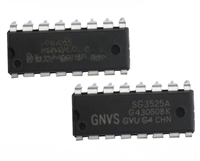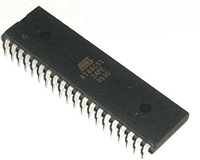KKA1062/1062A
FUNCTIONAL DESCRIPTION
At line currents below 9mA the internal reference voltage is
automatically adjusted to a lower value (typically 1.6V at 1mA). This
means that more sets can be operated in parallel with DC line voltage
(excluding the polarity guard) down to an absolute minimum voltage
of 1.6V. At line currents below 9mA the circuit has limited sending
and receiving levels. The internal reference voltage can be adjusted
by means of an external resistor (RVA). This resistor when connected
between LN and REG will decrease the internal reference voltage
and when connected between REG and SLPE will increase the
internal reference voltage.
Supplies VCC, LN, SLPE, REG and STAB
Power for the IC and its peripheral circuits is usually obtained from
the telephone line. The supply voltage is delivered from the line via a
dropping resistor and regulated by the IC. The supply voltage VCC
may also be used to supply external circuits e.g. dialing and control
circuits.
Decoupling of the supply voltage is performed by a capacitor
between VCC and VEE . The internal voltage regulator is decoupled by
a capacitor between REG and VEE.
Microphone inputs MIC+ and MIC- and gain pins
GAS1 and GAS2
The DC current flowing into the set is determined by the exchange
supply voltage Vexch , the feeding bridge resistance Rexch and the DC
resistance of the telephone
The circuit has symmetrical microphone inputs. Its input impedance
is 64 kΩ (2 x 32kΩ) and its voltage gain is typically 52 dB (when R7
= 68k?; see Fig.6).
line Rline
.
Dynamic, magnetic, piezo-electric or electret (with built-in FET
source followers) can be used.
The circuit has internal current stabilizer operating at a level
determined by a 3.6 kΩ resistor connected between STAB and VEE
(see Fig.6). When the line current (Iline) is more than 0.5mA greater
than the sum of the IC supply current (ICC) and the current drawn by
the peripheral circuitry connected to VCC (Ip) the excess current is
shunted to VEE via LN.
The gain of the microphone amplifier can be adjusted between 44 dB
and 52 dB to suit the sensitivity of the transducer in use. The gain is
proportional to the value of R7 which is connected between GAS1
and GAS2.
The regulated voltage on the line terminal (VLN) can be calculated as:
Stability is ensured by two external capacitors, C6 connected
between GAS1 and SLPE and C8 connected between GAS1 and
VEE. The value of C6 is 100pF but this may be increased to obtain a
first-order low-pass filter. The value of C8 is 10 times the value of
C6. The cut-off frequency corresponds to the time constant R7 x C6.
V
V
LN = Vref + ISLPE x R9
LN = Vref + {(Iline - ICC - 0.5 x 10-3A) - Ip} x R9
Vref is an internally generated temperature compensated reference
voltage of 3.7V and R9 is an external resistor connected between
SLPE and VEE.
Input MUTE (KKA1062A)
In normal use the value of R9 would be 20?.
When MUTE is LOW or open-circuit, the DTMF input is enable and
the microphone and receiving amplifier inputs are inhibited. The
reverse is true when MUTE is HIGH.
MUTE switching causes only negligible clicking on the line and
earpiece output. If the number of parallel sets in use causes a drop in
line current to below 6 mA the DTMF amplifier becomes active
independent to the DC level applied to the MUTE input.
Changing the value of R9 will also affect microphone gain, DTMF
gain, gain control characteristics, sidetone level, maximum output
swing on LN and the DC characteristics (especially at the lower
voltages).
Fig.2 Equivalent impedance circuit
Dual-tone multi-frequency input DTMF
When the DTMF input is enable dialing tones may be sent on to the
line. The voltage gain from DTMF to LN is typically 25.5 dB (when
R7=68kΩ) and varies with R7 in the same way as the microphone
gain. The signalling tones can be heard in the earpiece at a low level
(confidence tone).
Receiving amplifier IR, QR and GAR
The receiving amplifier has one input (IR) and a non-inverting output
(QR). The IR to QR gain is typically 31dB (when R4 = 100kΩ). It
can be adjusted between 20 and 31dB to match the sensitivity of the
transducer in use. The gain is set with the value of R4 which is
connected between GAR and QR. The overall receive gain, between
LN and QR, is calculated by subtracting the anti-sidetone network
attenuation (32dB) from the amplifier gain. Two external capacitors,
C4 and C7, ensure stability. C4 is normally 100pF and C7 is 10 times
the value of C4. The value of C4 may be increased to obtain a first-
order low-pass filter. The cut-off frequency will depend on the time
constant R4 x C4.
Under normal conditions, when ISLPE >>ICC + 0.5mA + Ip, the static
behaviour of the circuit is that of a 3.7V regulator diode with an
internal resistance equal to that of R9. In the audio frequency range
the dynamic impedance is largely determined by R1. Fig.2 show the
equivalent impedance of the circuit.
The output voltage of the receiving amplifier is specified for
continuous-wave drive. The maximum output voltage will be higher
under speech conditions where the peak to RMS ratio is higher.
Automatic gain control input AGC






 SG3525资料手册详解:SG3525参数分析、引脚说明、应用介绍
SG3525资料手册详解:SG3525参数分析、引脚说明、应用介绍

 AT89C51单片机资料手册详细解析及应用示例
AT89C51单片机资料手册详细解析及应用示例

 CP2102资料手册解读:CP2102引脚说明、关键参数分析
CP2102资料手册解读:CP2102引脚说明、关键参数分析

 资料手册解读:UC3842参数和管脚说明
资料手册解读:UC3842参数和管脚说明
